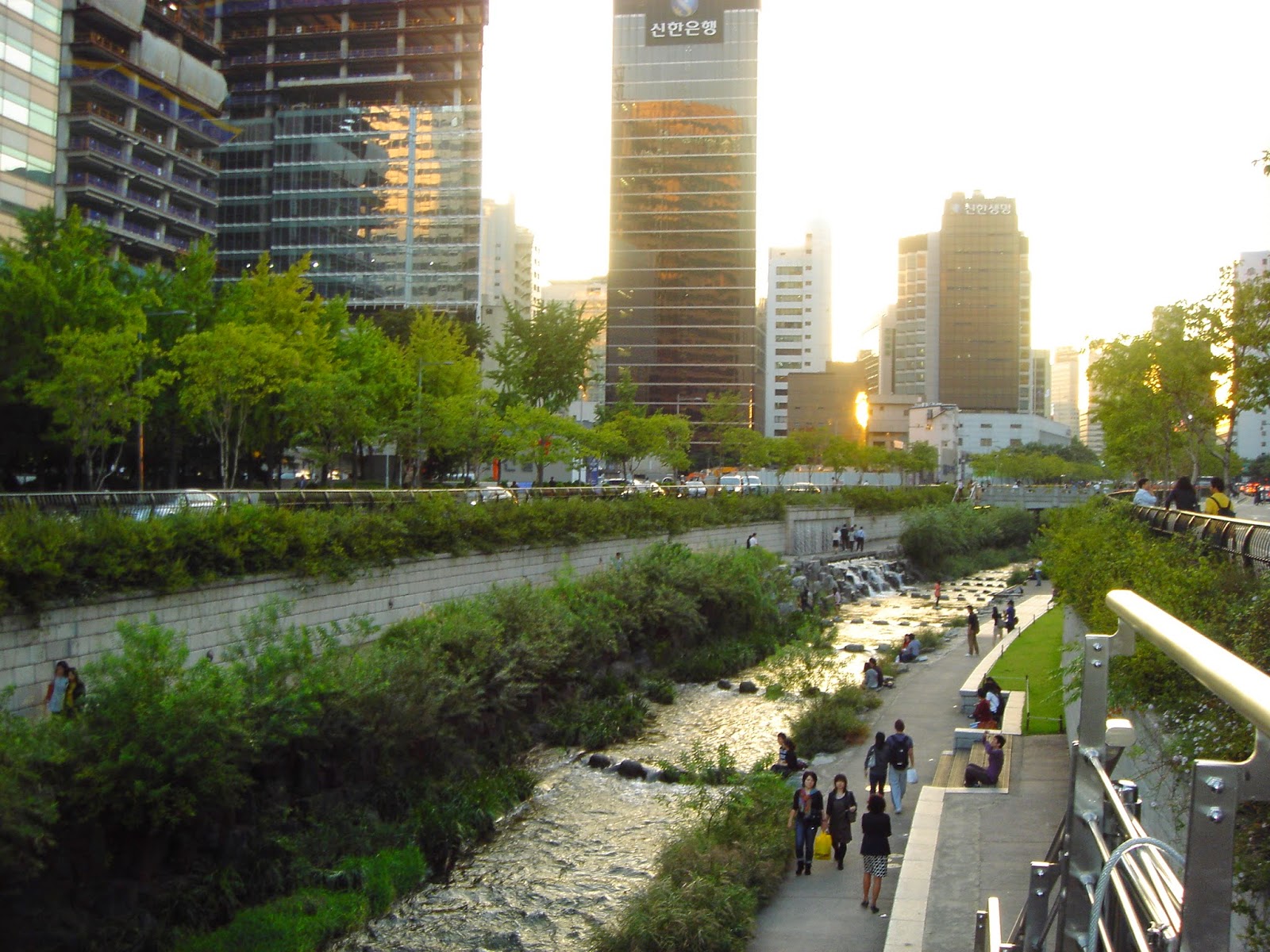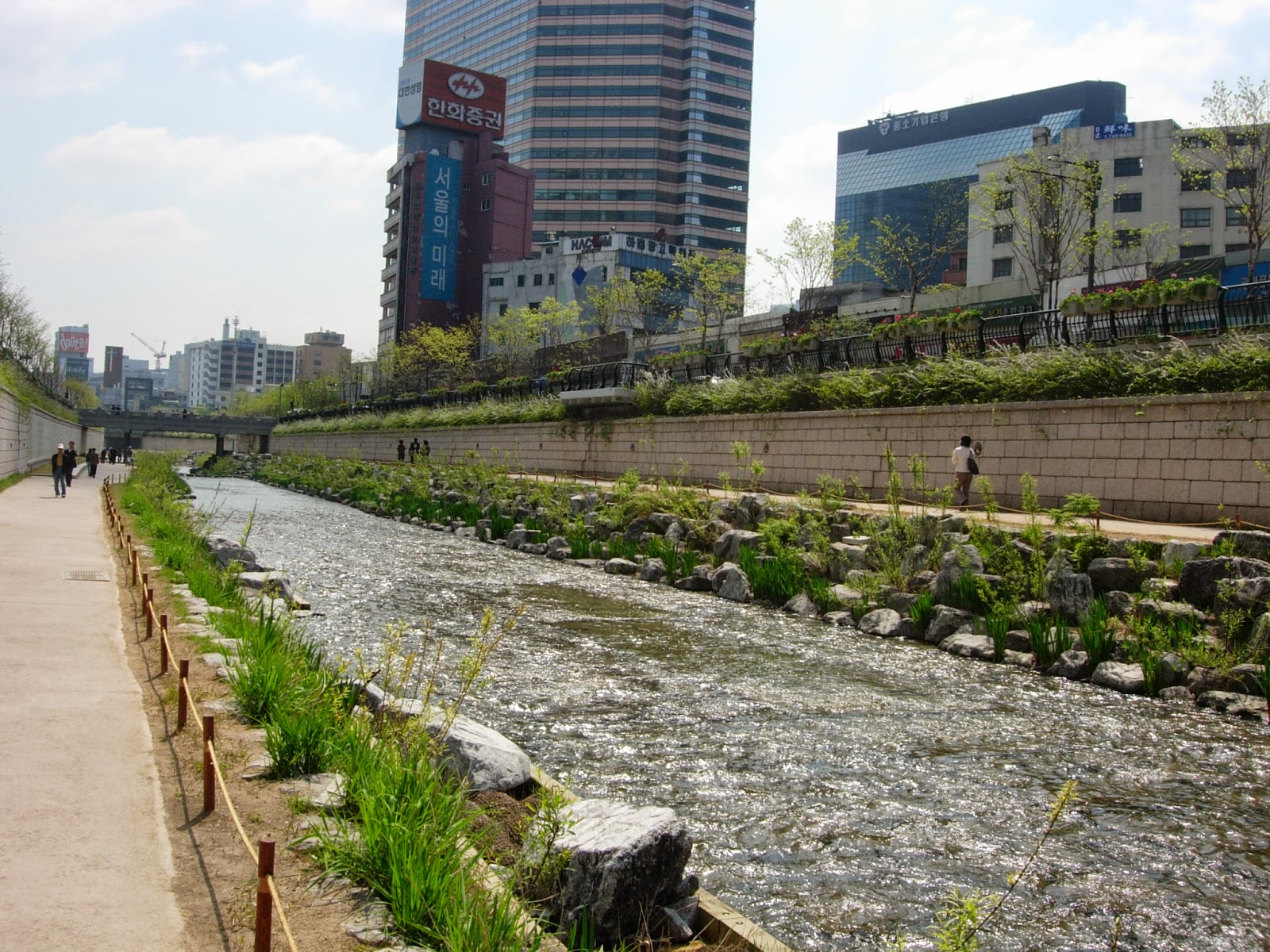In the
heart of Seoul, of stone jungle, there is a piece of paradise. Cheonggyecheon stream - is one of the main
attractions of the city, and, of course, known to many tourists.
Honestly, I
don’t like the popular tourist destinations, I'm interested in more unknown
areas, but as a person who loves history, I could interested in the river,
which history is very interesting
It would
seem that may be interesting in the history of the stream, and from her the
story, all come from? But not all so simple. The stream was named Gaecheon
("open stream") after the first refurbishment project to construct a
drainage system during the Joseon
Dynasty. The work, which included dredging and bolstering the banks of the
stream and building the bridges, was carried out every 2~3 years during this
period from the reign of Taejong, the third king of the Joseon
Dynasty. During
the reign of King Sejong, the Cheonggyecheon was recognized as an important
achievement for people's everyday life.
At that time, there were no particular drainage
systems. Thus, trash and wastewater flowed into the Cheonggyecheon in downtown
Seoul. For about half a century and until King Yeongjo came to the throne,
after the changes made by Kings Taejong and Sejong, the stream saw no drastic
change. Its capability remained sufficient to carry out household wastewaters
from around 100,000 Seoulites. But after
the Japanese invasion the situation changed. Gacheon was renamed to Cheonggyecheon, its
current name, during the Japanese colonial period. During this time, financial difficulties
prevented the colonialists from covering up the stream despite several attempts
to do so.
And dredging work was started in February 1760, dividing the main stream
and its tributaries into a total of eight zones and fixing the damaged bridges.
The work included overhauling water channels in all royal palaces.
By 1945, when the nation was liberated from the Japanese colonial rules,
the Cheonggyecheon was filled up with trash, ground and sand swept from the
bare mountains and severely contaminated with wastes from shabby makeshift
houses built alongside. After the Korean War (1950~1953), even more people
swarmed into Seoul to find their way and make their living and settled down
along the stream.
Those living in houses near the stream suffered a lot due to the stench
caused by the large amount of wastes flowing into the stream. Thus, the image
of Seoul had also been severely affected. The stream was covered up with concrete over a
20 year period starting in 1958, and a 5.6 km-long, 16 m-wide elevated
highway was completed in 1976. The area became an example of successful
industrialization and modernization of South Korea.
By the end of the 1950s, it
became a symbol of poverty and slovenliness, being filled up with trash and
wastes. During the 1960s and 1970s, it was regarded as an example of successful
industrialization and modernization. Then, in the 1980s and 1990s, it came to
be regarded as a source of intense traffic, health and environmental issues. Seoul mayor, Lee Myung-bak initiated a project to remove
the elevated highway and restore the stream. It was a major undertaking as not
only did the highway have to be removed, but as years of neglect and
development had left the stream nearly totally dry.
New Cheonggyecheon is elongated in one line
landscaped park in the city center, where you can walk along the river. You can
seat on the stones and to wet feet in the clear water, you can admire the many
diverse fountains. At the source of the stream are several fountains: in the
form of candles, fireworks fountain and a large two-tiered fountain. Downstream
there is also a fountain-tunnel. It is especially beautiful fountains at night
when illuminated. The stream is quite long. In his over 22 bridges built, but
in many places you can go river also specifically laid out the stones.
Besides
fountains, there are several "walls". The
Wall of Hopes was installed on both sides of the 50-meter-long wall located
between Hwanghakgyo and Biudanggyo. More
than 20,000 citizens directly wrote and painted their own hopes and desires on
the 10m x 10m ceramic tiles. This is a monument of the Cheonggyecheon
Restoration Project developed by a nation of provinces, metropolitan cities, 5
provinces in North Korea, and Korean nationals abroad, as well as by the
citizens of Seoul. Individual hopes are expressed on the tile.
Visitors to the Cheonggyecheon will be able to appreciate this Banchado
as a tile wall painting, comprising of 5,120 pieces of ceramic tiles (each the
size of W-30cm and H-30 cm). Banchado of King Jeongjo is a painting of the
Joseon Dynasty's King Jeongjo's 8-day royal procession to Hwaseong to visit his
father's thumb to celebrate his mother's 60th birthday. This wall can be
spotted from afar, because the march king suite, consisting of 1779-five
soldiers, accompanied by drums and bagpipes wailing. Until I did not
immediately realized that the music flows directly out of the wall, well, or
from the speakers built into it. Music is so attractive that you don't wanna go.
Since we spent on the stream most of the day, you've seen the sun gives
way to the moon, and the atmosphere is changing. During the day, the creek is a family park. Grandparents, parents with
kids, walk along the creek or resting on benches. The water in the creek
Chhongechon clean enough, it is possible to see the fish, parents allow
children to splash here. Fun and laughter of children everywhere.
In the evening, the atmosphere changes. Along the creek illuminate
thousands of lights, fountains dance in the colored lighting, street musicians
and singers arrange different views. And in the night, in the moonlight, many
loving couples occupy benches. Here by the way, you have to be very careful, you
stumble upon a couple that went further kisses and cuddle.
Despite the fact that the creek flows through the center of Seoul, and
quite a lot of people here, this place is ideal for relaxation, away from the
city bustle and pressing problems.
Historical photos from http://koreabridge.net/
В самом центре Сеула, среди
каменных джунглей, находится кусочек рая. Ручей Чхонгечон – является одной из
главных достопримечательностей города, и, конечно, известен многим туристам.
Честно сказать, я не очень
люблю популярные туристические места, меня интересует более неизвестные
области, но как человек любящий историю, я не могла не заинтересоваться
ручейком, у которого она очень интересная.
Казалось бы, что может быть
интересного в истории ручья, и откуда ей, этой истории, вообще взяться? Но не
все так просто.
Изначально ручей был творением природы и играл немаловажную
роль еще в эпоху Чосон. В то время, вдоль реки селилось много людей, а из-за
частых наводнений, река очень загрязнилась. Королем Тхэчжоном, было принято
ручей демонтировать, несколько месяцев велись строительные работы по углублению
дна и воздвижению дамб. В те времена, ручей называли «Гечон» - выкопанная
речка. Правящий после Тхэчжона, король Сечжон, продолжил перестраивать ручей.
Его расширение привело к тому, что ручей стали использовать для своих нужд, что
превратило его попросту в городскую канализацию.
Во время японской оккупации,
ручей был переименован в Чхонгечон, однако, после завершения корейской войны,
ручей был практически полностью разрушен и заброшен.
Его ассоциировали только,
со старостью и беднотой. Дабы избавиться
от «клоаки», правительство приняло решение, засыпать ручей и построить на его
месте двухъярусную автомагистраль.
Перестройка
и бетонирование реки проходили в четыре этапа — в течение 22 лет!
Навесная магистраль шириной в четыре полосы и длиной почти в 6 километров
проходила над основной дорогой.
Спустя тридцать лет, Сеул
превратился в развитый мегаполис, но, к сожалению, с одним единственным крупным
парком на горе Намсан. Жителям нужны были места отдыха, что-то чистое и
экологическое. Место, куда можно прийти и отдохнуть всей семьей. Тут-то
правительство и вспомнило о погребенном ручье. А именно, бывший президент Ли
Мен Бак (тогда еще мэр), предложил вернуть городу его историческую
достопримечательность. Был разработан грандиозный проект, по плану которого,
надо было полностью снести автотрассу. И вот, в 2005 году, ручей был
восстановлен.
Новый Чхонгечон представляет собой вытянутый в одну
линию ландшафтный парк в самом центре города, по которому можно гулять вдоль
реки.
Можно сесть на камушки и помочить ноги в чистой воде, можно полюбоваться многочисленными
разнообразными фонтанами.
У истоков ручья находятся несколько фонтанов: в
форме свечи, фонтан-фейерверк и большой двухъярусный фонтан. Ниже по течению
есть также фонтан-тоннель.
Особенно красивы фонтаны именно ночью, при
подсветке.
Ручей довольно длинный. На его протяжении построено 22 моста,
но во многих местах речку можно перейти также по специально выложенным
камням.
Кроме фонтанов, тут есть несколько
"стен". Стена Надежды украшает обе стороны набережной ручья и
выражает трагедию и боль разделения Кореи на два государства и надежду на их
объединение. Стена облицована керамическими плитками, на которых оставили свои
записи 20 тысяч корейцев: как жителей Сеула, так и Северной Кореи и зарубежных
диаспор. Автографы оставлены, как знак надежды на объединение корейских
государств.
Самая большая в мире керамическая стена Панчхадо украшена
росписями, посвященными поездке 22-го короля династии Чосон, императора Чончжо
на могилу родителей. Эту стену можно заприметить еще издалека, так как поход
свиты короля, состоящей из 1779-ти воинов, сопровождает бой барабанов и плач
волынки. До меня не сразу дошло, что музыка льется прямо из стены, ну или из
динамиков, встроенных в нее. Музыка настолько притягательна, что идти дальше
даже не хочется.
Так как мы провели на ручье почти весь день, то видели, как
солнце сменяется луной, и атмосфера ручья меняется.
Днем, ручей – это семейный
парк. Бабушки, дедушки, родители с детишками, гуляют вдоль ручейка или отдыхают
на лавочках. Вода в ручье Чхонгечон достаточно чистая, в нем можно увидеть
рыбок, родители разрешают тут плескаться детям. Веселье и детский смех повсюду.
Вечером же, атмосфера меняется. Вдоль ручья загораются
тысячи огоньков, фонтаны пляшут в свете разноцветной подсветки, уличные
музыканты и певцы устраивают различные представления. А в ночи, в лунном свете,
многочисленные влюбленные парочки оккупируют лавочки. Тут кстати, надо быть
очень осторожным, нет- нет, да наткнешься на парочку, которая зашла дальше
поцелуйчиков и обнимашек.
Несмотря на то, что ручей протекает через центр Сеула и
здесь довольно-таки много людей, это место идеально для отдыха, от городской
суеты и насущных проблем.
Исторические фотографии от http://koreabridge.net/































Беспалевные парочки :D
ОтветитьУдалитьСпасибо за рассказ. Я знала немного об этом месте, но не так много. Было интересно читать.
да вообще не палятся)))
Удалитьне за что)
Как я люблю такие исторические посты *О* здорово))
ОтветитьУдалитья тоже хахах сэнкс)
Удалить